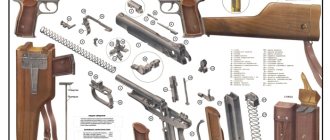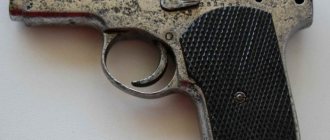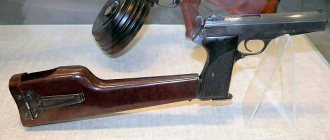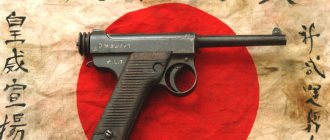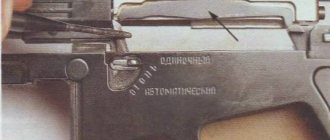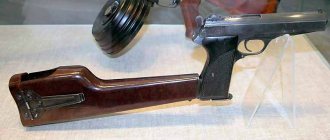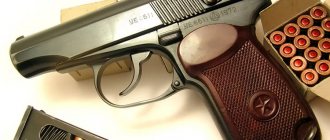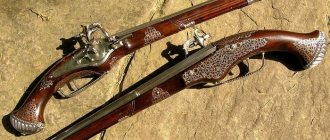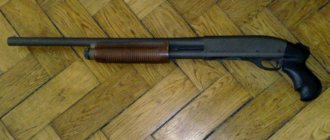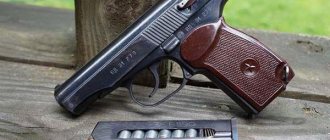Home | Weapons | Pistols | Czech Republic | CZ 82 / 83
Pistol CZ 82
The CZ 82 appeared thanks to the adoption of the VZ.82 (pistolovy naboj vz.82) cartridge into service by the army and law enforcement services of Czechoslovakia in 1982. This cartridge, which replaced the old 7.62×25, is essentially the same 9×18 for the PM pistol, only with a powder charge increased by 20%. The new pistol, created by Ceska Zbroevka in the city of Uhersky Brod, differed from other short-barreled weapons then in service with the Warsaw Pact countries by using a large-capacity magazine with a double-row arrangement of cartridges. To adopt a new pistol for the law enforcement agencies of Czechoslovakia, a competition was held with the participation of the Russian PM, Polish P-64 and Hungarian R 61. The Czechoslovak pistol won, after which its mass production was launched in 1983 under the name armadni pistol vz. 82.
Pistol CZ 82
Automation works according to the scheme of using recoil with a free shutter. The trigger mechanism is hammer-type, double-action, with safety cocking. The pistol is distinguished by the presence of a double-sided safety lever, the levers of which are located on both sides of the rear part of the frame. In the on position, the fuse blocks the sear and the bolt-casing. The magazine release is also double-sided. The bolt stop lever is located on the left side of the frame. The large trigger guard allows shooting with thick gloves. The frame and bolt casing are made of weapon steel. Sights CZ 83 consist of a replaceable front sight and a non-adjustable rear sight, mounted in a dovetail groove with the possibility of making horizontal adjustments. The front and rear sights have white round inserts to speed up and simplify aiming of the weapon at the target in low light conditions. The coating is blue bluing or matte nickel plating, as well as a black polymer coating.
Pistol CZ 83
For export sales, also in 1983, the production of the CZ 83 model was launched, differing from the previous model in a different shape of the trigger guard and the use of 7.65mm Browning and 9mm Short cartridges. The CZ 83, being one of the best in the class of compact short-barreled weapons, was and remains a strong competitor to the Makarov pistol. Compared to the PM, the Czech pistol has a more comfortable grip to hold and is better controlled when shooting. The double-sided safety allows you to operate the weapon equally comfortably when holding it with both the right and left hands. The Czech pistol has a smoother trigger pull. The double-stack magazine provides an advantage in firepower. But at the same time, CZ has a more complex design and higher cost. According to the experience of the owners, the service life of the pistol exceeds 10,000 shots without breaking the main parts of the weapon, but there have been cases of breakage of the strikers in the region of 8,000 - 9,000 shots.
Pistol CZ 83
Of course, modern requirements for compact weapons are much higher than the qualities of a pistol created in the early 1980s, especially in terms of weight and dimensions. However, it is valued for its strength, durability and high quality. The main advantages of the pistol are high operational reliability and ease of maintenance due to the simplicity of the design, constant combat readiness, safety in handling, small dimensions and weight. Disadvantages are the presence of a manually controlled safety, which complicates the handling of the weapon, the lack of a system for safely releasing the hammer from the combat cock, as well as the insufficient stopping and penetrating effect of the bullet of the cartridge used. CZ 83 pistols are in stable demand in the civilian arms market in Europe and the USA. The CZ 82 continues to be in service with the armies of the Czech Republic and Slovakia. Since 1992, the production of the CZ 82 and CZ 83 models has been combined. The weapon was produced only under the designation CZ 83 chambered for three cartridges. Currently, the CZ 83 is supplied to the Czech armed forces and to the civilian arms market in various countries around the world.
Design of CZ 82 and CZ 83 pistols
The automatic operation of both pistols is based on the use of recoil energy when the bolt moves freely. The trigger mechanism is double action, hammer type with an external trigger. For the safety of wearing Cheset 82 and Cheset 83, there is one fuse, the control flag of which is double-sided and is convenient for turning on and off with one finger. When activated, the safety restricts the movement of the sear and holds the bolt housing in place.
Both pistols have the same mechanisms, but are designed for cartridges of different calibers and powers.
The bolt stop lever is located on both sides, located above the trigger guard of an enlarged shape (for shooting with gloves). For the convenience of the shooter, the magazine release button is installed on both sides at once, and in such a way that it is impossible to accidentally press it.
The pistol is made of high-quality weapon steel.
Sights consist of a conventional front sight and a dovetail rear sight with the ability to adjust the aiming line. The pistol body is nickel-plated or blued, depending on the model and order.
The cartridges are fed from detachable box magazines with a capacity of seventeen rounds. The magazine is double-row, with staggered cartridges.
Pistol magazines chambered for 9 mm caliber are interchangeable.
In 1983, it was decided to supply the pistol abroad. But abroad there was a need for inexpensive weapons for other calibers, so the commercial model CZ-83 appeared, which completely copied the 82 model, but in three calibers at once - 9x17, 9x18 and 7.65x25 mm. Over time, the Model 82 was discontinued to free up production capacity, and the CZ-83 was officially adopted into Czech service.
Automatic pistol CZ 83, caliber 7.65 and 9 mm
Since the end of 1983, this model has been mass-produced by enterprises of the state arms plant Cesko-slovenska Zbrojovka (CZ). The design of this weapon responded to the international trend towards using weapons with a large magazine capacity. The magazine holds 15 rounds of Browning 7.65×17 HR. Weapons were supplied both to our own armed forces and police, and for export.
Pistol CZ 83, caliber 7.65 mm
The automatic operation of the CZ 83 pistol is based on the use of recoil energy. The weapon has a fixed barrel and a blowback bolt. The bolt extractor and ejector port are located on the right side. Auxiliary elements (fuse and magazine release) are located on both sides. There is no striker safety. The CZ 83 pistol features a slide lock, which is not typical for pistols of this caliber. After the last cartridge is fired, the bolt remains in the rear position. After replacing the empty magazine with a full one and actuating the magazine release lever, moving the bolt forward and feeding a round into the chamber, the weapon is ready to fire.
pistol CZ 83, caliber 9 mm
In order to use the pistol even with gloves, the trigger mechanism has been designed accordingly. The stronger handle, compared to the handles of the CZ 50 and CZ 70 models, has become more massive due to the larger magazine. The cartridges are located in the store in two rows. Thanks to the holes in the magazine, you can determine how many cartridges it contains. The thickness of the weapon is 36 mm, the rifling pitch length is 250 mm.
The sighting mechanism consists of a fixed sight with a wide slot and a small front sight for fast aiming with cross-checking. The white night-time markings on the front sight and both sides of the sight cutout help you quickly get the weapon on target. You can shoot with the hammer cocked or self-cocking, overcoming a resistance of 1.5 kg, which lengthens the trigger path.
The weapon, which can be used without restrictions by left-handers, has a comfortable handle curve and fits well in the hand. Even with a high frequency of shots, you can keep the target under the gun. The plastic cheeks of the handle have a recess for the thumb and corrugation, providing a secure grip. The handle and sides of the bolt are polished and blackened. In addition to the 7.65 mm pistol, CZ produces the Model 83 in another version - with a larger caliber but a smaller magazine capacity, which uses Browning 9x17 cartridges.
Characteristics: automatic pistol CZ 83 7.65 mm Caliber, mm…………………………………………………………….7.65 Initial bullet velocity (Vq), m/s …………………………….300 Weapon length, mm……………………………………………………172 Weapon height, mm……………………… ……………………………..127 Length of the sight line, mm…………………………………………126 Weight when charged, kg………………… ……0.870 Weight with empty magazine, kg…………………………….0.750 Cartridge………………………………………………………7.65× 17 HR Barrel length, mm………………………………………………………96 Rifling/direction……………………………………………………….. 6/— Magazine capacity, cartridges……………………………………15 Effective range, m………………………….50
Characteristics: automatic pistol CZ 83 9 mm Caliber, mm………………………………………………………………………………….9 Initial bullet velocity (Vp), m/s…… ……………………….280 Weapon length, mm……………………………………………………172 Weapon height, mm………………………… ………………………..127 Sight line length, mm…………………………………126 Weight when charged, kg………………………… 0.915 Weight with empty magazine, kg……………………………….0.800 Cartridge…………………………………………………………………………………..9 ×17 Barrel length, mm………………………………………………………96 Rifling/direction……………………………………………………….. 6/— Magazine capacity, cartridges……………………………………12 Effective range, m………………………….50
Comparison of CZ-82 and 83 with the Makarov pistol
Compared to its direct competitor, the Czech pistol wins mainly in build quality, as well as improved ergonomics and controllability. At the same time, Chezet 83 demonstrates better combat characteristics, mainly due to a more comfortable launch and ambidextrous controls - the pistol is convenient for both left-handed and right-handed people. The double-stack magazine provides double the firepower advantage. At the same time, the pistol is more complex in design and more expensive to produce when compared with its Soviet counterpart.
But the Czech pistol also has its drawbacks - for example, not all models reach their service life of ten thousand shots without breakdowns, as stated in the manufacturer’s documentation. The increased complexity of disassembly for lubrication and cleaning requires higher operator skill and care during assembly.
CZ
History of the CZ company.
In 1936,
a modern and technologically advanced arms factory was created in the city of Uherský Brod, in the Czech Republic. It was moved away from the western borders, as it was threatened by attack by Nazi Germany. The main focus at first was aircraft machine guns.
After World War II, the nationalization of Česká zbrojovka took place. The leader in production at the time was the Model 48 submachine gun. In 1950, the Model 48 was renamed the 23/25 and chambered in 9mm Parabellum. The small size and excellent design ensured production of more than 545,000 units by 1953.
In 1959
In 2009, production of model 58 submachine guns began in 7.62x39 caliber. Now this model can be classified as an assault rifle. Model 58 was an alternative to the Kalashnikov assault rifle. The original design and high quality ensured high popularity. The Model 58 was supplied both to the national armed forces and for export. Almost 1 million units were produced.
In 1962
In 2009, production of the compact Scorpion submachine gun, model 61, began. This model became an intermediate link between an assault rifle and a pistol. Until 2000, more than 207,000 units were produced in 7.65 Browning (aka .32 Auto). Previously, there was a small batch for the 9x19mm Parabellum caliber.
In 1975
In 2009, production of the legendary CZ 75 pistol began. Designer Frantisek Kutsky has been working on the creation since 1969. Excellent ergonomics, double-action trigger, spacious magazine, weight, these qualities ensured the popularity of this model.
In 1992
privatization took place and a joint stock company was created. In addition to high-quality weapons, Ugorské Brod began to produce components for the automotive and aviation industries.
In 1997
In 2009, the subsidiary company CZ-USA was founded, which made it possible to enter the American market and become part of the international holding Česká zbrojovka Group. The company is located in Kansas.
In 2004
year the company Zbrojovka Brno was acquired.
In 2006
In 2008, CZ-USA acquired Dan Wesson Firearms. Dan Wesson Firearms was founded in 1968 by the great-grandson of the legendary Daniel B. Wesson.
In 2011
year, a contract was concluded for the supply of weapons to the Czech Army. Serial production of the CZ 805 BREN A1/A2 rifles, CZ SCORPION EVO 3 A1 submachine guns and CZ 805 BREN G1 grenade launchers has begun.
In 2016
An assembly shop opens in Peru. This allows us to provide production and service throughout Latin America.
In 2018
year the CZ Group holding was created. Now other companies with related programs and developments are also involved in production.
In 2019
year, in cooperation with CZ-USA, the production of weapons was started in the USA. The leader in production was the CZ P-10.
At the moment, the company is one of the world leaders in the production of military and civilian weapons.
Performance characteristics (TTX) of Chezet 82 and 83 pistols
| Characteristics | CZ 82 | CZ 83 |
| Caliber | 9x18 VZ.82 | 9x17, 9x18 and 7.65 mm |
| Gun length, mm | 172 | 172 |
| Barrel length, mm | 97 | 97 |
| Weapon height, mm | 127 | 127 |
| Weapon width, mm | 36 | 36 |
| Weight without cartridges, kg | 0,92 | 0,8 |
| Magazine capacity | 12 rounds | 12/12/15 rounds |
Users[edit]
- Czech Republic [4] (Withdrawn from service. Replaced by CZ 75. Now usually used by reservists)
- Indonesia: foresters [5]
- Israel: law enforcement
- Iraq: Used in the Gulf War
- Georgia
- Kazakhstan: in 1998, 20 CZ-83 pistols were purchased for the Ministry of Internal Affairs [6]
- North Korea [7]
- Slovakia [8]
- Vietnam: [9] The Makarov model 9×18mm CZ 83 was imported in the 1980s and is now still in use by the Vietnam People's Army and the Vietnam People's Public Security.
CZ 83 is disassembled into its main components.
Time relay VL-81, VL-82, VL-83
The main purpose of time relays VL-81, VL-82, VL-83 is to use them as a switching relay. Time relays VL-81, VL-82 and VL-83 are used for switching electrical circuits (up to three) with certain, preset time delays in automatic control schemes for various technological processes.
The time relay of this series is available in three versions, which have similar technical parameters, but differ in the following features:
- relays VL-81, VL-83 are produced with a protruding front wire connection, and the VL-82 relay model is produced with a rear recessed wire connection and a cover that limits access to adjusting settings and sealing the unit;
- modification VL-81 and VL-82 (a more modern analogue of the VL-56 relay) form a time interval when applying current, and VL-83 both when turning on and off;
- relay VL-83, unlike other models, has 3 circuits, the parameters of which can be set by the user independently.
Interpretation of VL-81, VL-82, VL-83, markings
VL - series of time relays; 81(82, 83) — development serial number; X4 - climatic version and placement category according to GOST 15150-69: UHL4, O4.
Design and operation of time relays VL-81, VL-82 and VL-83
Time relays of this type are produced using semiconductor parts. Relay contacts are used to output voltage. In relay models VL-81 and VL-82, the time delay parameters are set using 6 switches, and in VL-83 the values are set using 6 blocks, each of which has 7 lever switches.
Applying current to the input VL-81, VL-82 leads to the installation of the system in the initial position, there is no current on the relay, and the timing countdown starts in all 3 circuits. At the end, the relay that has the lowest value is activated, the output relay is activated and switches the contacts, then the remaining relays are activated one by one. Turning off the current returns the relay to its original position.
The VL-83 time relay has an adjustment of the time delay for turning off and turning on each circuit, but they can function together only in a common range. Each of the 3 circuits creates 2 time settings, that is, for turning on and turning off. The relay also has an operating mode switch. In single mode, the relay operates once, and in the “cycle” mode, after turning off the third circuit, all relays return to their initial position and the cycle repeats.
Technical characteristics of time relays VL-81, VL-82 and VL-83
| Parameter name | Standard for execution | ||||
| VL-81 | VL-82 | VL-83 | |||
| Setting ranges (by version) with the same ranges for all three circuits | 0.1 - 9.9 s | 0.1 s - 100 min | |||
| 0.1 - 9.9 min | |||||
| 0.1 - 9.9 h | |||||
| 1 - 99 s | 0.1 min - 100 h | ||||
| 1 - 99 min | |||||
| 1 - 99 h | |||||
| Availability and type of time delay adjustment | stepped | ||||
| Function performed | protruding with front wire connection | recessed with rear wire connection | protruding with front wire connection | ||
| Rated supply voltages: | DC | 24; 110; 220 V | |||
| A.C. | 24; 110; 220; 230; 240 V | ||||
| Accuracy class: | for versions 0.1 - 9.9 s | 1,5 / 0,5 | |||
| for other versions | 1,5 / 0,1 | ||||
| Ready time, no more | 0.3 s | 0.5 s | |||
| Return time, no more | 0.2 s | ||||
| Installation resolution in fractions of the maximum setting | 0,01 | Tmin | |||
| Power consumption | 5 VA | 4.5 VA | |||
| Relay protection level: | by shell | IP40 | |||
| terminal block | IP10 | ||||
| dimensions | 110 x 75 x 100 mm | ||||
| Weight | 500 g | ||||
The VL-83 model relay in each of the 3 circuits has turn-on and turn-off delays, which can be set within one of the sub-ranges:
| Execution | Subbands |
| 0.1 s - 100 min | 0.1 - 10 s |
| 1 - 100 s | |
| 0.1 - 10 min | |
| 1 - 100 min | |
| 0.1 min - 100 h | 0.1 - 10 min |
| 1 - 100 min | |
| 0.1 - 10 h | |
| 1 - 100 h |
All relay versions with a supply voltage of 220 V, 50 Hz can be connected to a voltage of 380 V, 50 Hz through an additional quenching resistor with a resistance of 15 kOhm with a power of at least 10 W and a shutdown of no more than ±5% of the nominal value.
Graphs of functions of time relays VL-81, VL-82 and VL-83
Upit – supply voltage; T1on, T2on, T3on – time delay settings for turning on the I, II, III circuits, respectively; T1off, T2off, T3off – time delay settings for disconnecting circuits I, II, III, respectively; Tts – cycle time setting for relay VL-83.
Connection diagram for time relay VL-81, VL-82 and VL-83
Overall dimensions of time relay VL-81, VL-82 and VL-83
- a - place of connection of wires;
- b - position of the terminals when connecting the wires at the front (VL-81, VL-83);
- c — position of the terminals when connecting the wires at the rear (VL-82);
- g — fastening the VL-82 relay to the panel with brackets;
- d - outline of the hole in the panel for installing the VL-82 relay.
Execution, ergonomics, quality
The pistol is entirely made of steel, which is the reason for its rather large, by modern standards, weight (920 g for 9 mm modifications and 650 g for 7.65 mm). Weight, on the one hand, makes it less convenient to constantly carry a weapon, on the other hand, it is a positive factor when shooting, ensuring the stability of the weapon and reducing recoil. The weight and ergonomic handle, according to all reviews, ensures comfortable holding of the weapon, accurate aiming and confident continuous fire. The double-sided safety makes it easier to control the pistol when shooting with both the right and left hands.
The pistol is available in several external versions - nickel-plated, blued and with a black polymer coating. The cheeks of the handle are made of black plastic or wood-like plastic.
According to reviews, the pistol is of high quality and reliability. The lifespan of the pistol is 12,000-15,000 shots; the magazine and trigger rod wear out the fastest. In comparison with its main competitor - the Makarov pistol, the CZ 82/83 is comparable in reliability, significantly improves in ease of use, but is structurally more complex and more expensive to manufacture.
GDZ The world around us Grade 3 workbook Part 1 Pleshakov
As for the features of the textbook, you can start right from the appearance of the textbook and talk a little about the content. The textbook is presented in three primary colors. White, green, pink. On the right side there is a large number 3, just above the inscription there is a workbook, the world around us and in the upper right corner the school of Russia.
As for the contents of the printed workbook, it begins quite trivially. The first tasks are related to knowledge of nature itself, the opportunity to express what it is all about, and give your explanation about it. The following is information about basic living nature (plants, fungi, animals, bacteria). There are examples of experiments with physical phenomena, such as measurements of mass, time, temperature. That is, the very foundations of all those sciences that we talked about in the previous paragraph are studied.
By the end of the workbook, not only physical phenomena and living nature are touched upon, but even the simplest and most obvious facts about man. About how and through what organs our vital activity in the environment is ensured. Issues of a healthy lifestyle, nutrition, bad habits, hygiene, and daily routine are touched upon. All this is also important and necessary, since it is not only information about the characteristics of a person, but also about his correct and healthy upbringing. Although, of course, first of all physical.
Links[edit]
- https://cz-usa.com/product/cz-83-9-mm-browning-satin-nickel-cal-380-auto/
- ↑
Nixon, Sterling (February 13, 2007).
"903050: RV 3311/2007-139" (PDF). Bureau of Alcohol, Tobacco, Firearms and Explosives
. Archived from the original (PDF) on April 9, 2011. Retrieved May 16, 2010. - Table on page 12 of the CZ 83 manual - https://cdn.cz-usa.com/hammer/wp-content/uploads/2014/04/cz83_en.pdf
- https://www.army.cz/assets/files/9334/zbrane_definit.pdf
- "Statistik 2016 BKSDA Jawa Timur" (PDF). BKSDA Java Timur. February 2022. p. 44. Retrieved January 8, 2022.
- Decree of the Government of the Republic of Kazakhstan No. 744 of August 5, 1998 “On permission from the Ministry of Internal Affairs of the Republic of Kazakhstan for the import of weapons with ammunition and power from the Czech Republic”
- https://weaponsman.com/?p=8193
- Jones, Richard D.; Ness, Leland S., ed. (January 27, 2009). Jane's Infantry Weapons 2009/2010
(35th ed.). Coulsdon: Jane Information Group. ISBN 978-0-7106-2869-5. - https://soha.vn/quan-su/quan-doi-nhan-dan-viet-nam-duoc-trang-bi-nhung-loai-sung-ngan-nao-20141011203220312.htm
